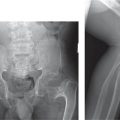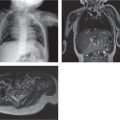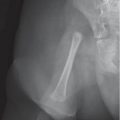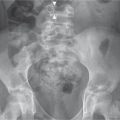Changes in Bone Density: Increased
Diagnosis | Findings | Comments |
Osteosclerosis of premature infants and neonates | Generalized increased density of all the bones. | Physiologic variant with no clinical signs. Normalizes within the first 3 mo. |
Bone infarcts Fig. 5.36, p. 519 | Patchy regions of increased sclerosis that may coalesce. | Bone infarcts after steroid therapy for inflammatory conditions or tumor treatment. Sickle cell disease. |
Renal osteodystrophy with secondary hyperparathyroidism Fig. 5.69, p. 542 | Diffuse sclerosis with trabecular thickening. | |
Vitamin D–resistant rickets on vitamin D therapy Fig. 5.62, p. 537 | Increased density of diaphyses and metaphyses. | During therapy, sclerosis develops at sites of prior lucency. |
Intrauterine infections | Increased diaphyseal and metaphyseal density. | Celery stalk pattern of the metaphyses. Congenital rubella and cytomegalovirus infections. |
Osteopetrosis (Albers-Schönberg disease) Fig. 5.67, p. 540 Fig. 5.80, p. 549 | Generalized increase in bone density. | Sclerosis obliterates bone marrow preventing hematopoiesis. |
Hypervitaminosis D | Increased metaphyseal cortical density, particularly at the diaphyseal junction. | After long-term ingestion of high doses of vitamin D. |
Williams-Beuren syndrome (Williams syndrome) | (see Table 5.45 ) | |
Fluorosis | Combined picture of osteomalacia, osteoporosis, and osteosclerosis. | Excessive consumption of fluoride. Bone pain and arthralgias. Calcification of ligaments. |
Melorheostosis Fig. 5.9, p. 498 | Marked cortical thickening and characteristic dripping candle wax appearance. | Localized painful swelling and growth disturbances. Follows distribution of dermatomes. |
Primary hypertrophic osteoarthropathy | (see Table 5.56 ) | |
Endosteal hyperostosis (van Buchem and Worth types) | (see Table 5.56 ) | |
Pycnodysostosis | Generalized bone sclerosis and mild modeling deformity of the bones. | Short-limbed dwarfism with generalized increase in bone density. Brittle bones. Acroosteolysis. |
Diaphyseal dysplasia (Camurati-Engelmann disease) | (see Table 5.56 ) | |
Erdheim-Chester disease (polyostotic sclerosing histiocytosis) | Usually affects adults. Progressive and widespread patchy sclerosis of the intramedullary region of bones with loss of the corticomedullary junction. Coarse trabecular architecture. Focal rib lesions. | |
Primary hyperoxaluria (oxalosis) | Osteoporosis in the early phase and diffuse bone sclerosis in the advanced stage. Subchondral sclerosis in the long bones. Metaphyseal sclerosis, dense epiphyses. | Growing ends of bones show bulbous enlargement. Pathologic fractures are common. Growth disturbance and increased incidence of urinary calculi due to hyperoxaluria. |
Related posts:
Stay updated, free articles. Join our Telegram channel

Full access? Get Clinical Tree








